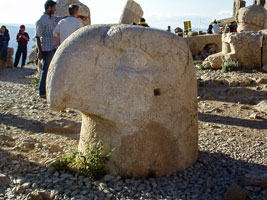Mount Nemrut (Nemrut Dağı) with its stunning scenery and giant stone statues offers breathtaking sights. The temple-tomb is rightfully considered by many as the eighth wonder of the world and is listed as a UNESCO World Heritage Site.
Historical Background
During the Hellenistic and Roman periods, the region that lies between the Taurus Mountains (Toros Dağları in Turkish) and the Euphrates, which encompassed the regions of Adıyaman, Maraş and Gaziantep, was called Commagene. Commagene was established as an independent kingdom in 162 BCE by Mithridates Kalinikos I. Mithridates brought together Persians and Macedonians and other communities in the area to found this powerful state and named it Commagene, which means "community of genes" in Greek. The kingdom was at the height of its splendour during the period of King Antiochos of Commagene (69-36 B.C.), who succeeded Mithridates. Most of the archaeological remains which survive to our times, including the tumulus at the peak of Mount Nemrut, which still refuses to reveal all its secrets, are from the time of Antiochos I.
Sights and Photos of Mount Nemrut
Our visit starts at Mount Karakuş, a tumulus at a distance of 12 km of the Kurdish village of Kahta near Adiyaman. This tumulus is thought to belong to the wife of Antiochos I. It is surrounded on four sides by columns. One of the columns is capped by the Roman eagle and another bears a relief of King Mithridates.
The bridge over the Cendere, a tributary to the river Kahta (Nymphaios), was built to honour the Roman Emperor Septimus Severus in 197 CE. It is constructed with a single arch and as such a typical example of Roman architecture. The bridge has a height of 18m and a length of 30m. Four columns decorated the bridge, two at each side. They represent the Emperor Septimus Severus, his wife Julia Domna and his two sons Caracalla and Geta. After the death of the Emperor, Geta was killed during the wall of accession and Caracalla ordered his brother's column to be removed. Therefore, only three columns remain.
Eski Kale (Old Castle) is the Turkish name for the ancient Commagene capital of Arsameia ad Nymphaios. A short walk uphill leads us to a large stele depicting either the sun god Mithras or the Greek god Apollo. Further, uphill there is a stone relief depicting Mithridates I shaking hands with the Greek hero Heracles. Next to it, there is a cave temple that descends 158m through the rock. It was probably used for rites concerning the worshipping of Mithras.
https://www.turkeyphotoguide.com/mount-nemrut?tmpl=component&print=1&page=#sigProIdf36a105072
Mount Nemrut, or Nemrut Dağı as it is called in Turkish, combines 8-10 meter-tall sculptures, the likes of which are to be seen nowhere else in the world, a pyramid located at a height of 2,000 meters, a king's tomb, whose precise location has not yet been determined, the world's oldest horoscope, and a mixture of ancient Greek and Persian art styles. Thus, it is little surprise that archaeology circles refer to Mount Nemrut as the eighth wonder of the world.
After arrival at the visitor's centre, it is a 600m (20 minutes) hike to the summit. The road takes us first to the eastern terrace where we are confronted with five giant sculptures on a podium. The statues are between 2 and 10 meters high and are in a reasonable condition, although their heads have fallen to the ground. For sunset visits, the western terrace is the place to be. Moreover, the statues are of greater beauty than those of the eastern terrace.
https://www.turkeyphotoguide.com/mount-nemrut?tmpl=component&print=1&page=#sigProId2b699b6290
Travel Information & Travel Tips
Mount Nemrut can be reached easiest from the Kurdish town of Kahta (54 km) in the Adiyaman province. A tour of about 3 hours takes you to the top. On the way, you visit the other remains of Commagene: Karakuş with the graves of the royal ladies, the Cendere Bridge, and the site of Arsameia ad Nymphaios, the ancient capital of Commagene. After being several times in this area, I'm convinced Kommagene Hotel – Camping Tel. (0416)-715 10 92 - 725 55 48 is the best place to stay at Kahta. The photos on this page are from our 2002 tour of Eastern and Central Anatolia, coming from Şanlıurfa.
































